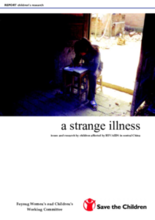This is a report of issues and concerns raised by orphans and children affected by HIV/AIDS in an area of central China with a severe HIV/AIDS epidemic. This project was undertaken as a preliminary study for a longer programme of child-focussed work in the area to provide care, support and treatment within a framework of child protection and children.s participation.
The epidemic was caused through blood-selling by poorer adults and the bad practices used by entrepreneurs in returning some mixed blood of several people to sellers. Large numbers of adults have died, many are dying and many are infected. Some children are also infected. Children are being orphaned. Many children are experiencing the severity of this impact emotionally and physically, yet have received only sporadic public attention. When they are publicly noticed, children frequently experience different forms of stigma and discrimination, either in being liable to be excluded by their peers and local institutions (schools), in being looked down upon, or in being placed in institutional or other care separate from their remaining family and community.
The research was devised to begin to address these perceptions and behaviours by taking children seriously, seeking the views of children on their current situation and about their future lives and hopes. Children’s issues were raised through a series of workshops with children, some research led and undertaken by children and a children’s forum, all conducted over a seven- month period, from February to August 2004. Most of the children involved were themselves affected by HIV/AIDS and included orphans who had lost one or both parents. Children were articulate in raising and discussing issues and competent in carrying out interviews with others. They enjoyed themselves enormously, made friends and supported each other.
The main findings of the project relate to children’s experiences and potential for exclusion, loneliness, isolation, uncertainties and their corresponding fears and worries for now and for the future. Children are most concerned about tensions and health within their family, friendships, stigma and discrimination, survival and the future of their families and themselves, and study – going to school and performing well. The feedback from children involved in the project show how the methods and activities used, including the approaches of taking children seriously, having fun, treating children with respect – participatory ways of working with children – were found to demonstrate and provide psycho-social support and personal development.
Children don’t want to leave their village. Children remaining in a familiar, identifiable community, with friends, attending school and maintaining family relationships is a primary aim, with the eradication of stigma and discrimination, and provision of social activities and support, and community networks as key objectives. This may be done by recognising children’s actual and potential resilience through their participation in decision making in a safe environment. Because of the current experiences of exclusion of some children, and the need to provide support to children through processes of separation and loss, children’s activity centres, properly facilitated with a central component of children’s participation, can be developed, around which can be built a range of projects to address their concerns, from skill training to treatment, and are also points from which to address problems of prejudice, stigma and discrimination that are especially significant in children’s lives.
Future work should include development of childrens activity centres, training for staff and volunteers, development of a network of community support for families and children, anti-bullying work in schools, anti-stigma and discrimination programmes, support for orphans and their families to enable them to remain in their communities, and access to education and healthcare.
©International Save the Children Alliance and Fuyang Womenâs and Childrenâs Working Committee

